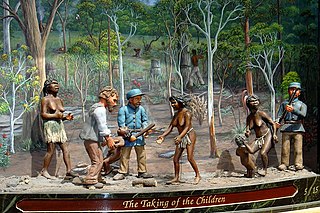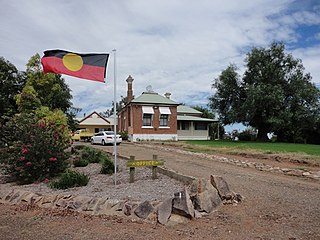Related Research Articles

The Stolen Generations were the children of Australian Aboriginal and Torres Strait Islander descent who were removed from their families by the Australian federal and state government agencies and church missions, under acts of their respective parliaments. The removals of those referred to as "half-caste" children were conducted in the period between approximately 1905 and 1967, although in some places mixed-race children were still being taken into the 1970s.
The Aboriginal Protection Act 1869 was an Act of the colony of Victoria, Australia that established the Victorian Central Board for the Protection of Aborigines, to replace the Central Board Appointed to Watch Over the Interests of the Aborigines. The Act made Victoria the first colony to enact comprehensive regulations on the lives of Aboriginal Australians. The Act and subsequent regulations gave the Board extensive powers over the lives of Aboriginal Victorians, including regulation of residence, employment, marriage, social life, custody of children and other aspects of daily life.
The role of Protector of Aborigines was first established in South Australia in 1836.


The Aboriginals Protection and Restriction of the Sale of Opium Act 1897(Qld), was an Act of the Parliament of Queensland. It was the first instrument of separate legal control over Aboriginal peoples, and was more restrictive than any contemporary legislation operating in other states. It also implemented the creation of Aboriginal reserves to control the dwelling places and movement of the people.
Aboriginal Affairs NSW (AANSW) is an agency of the Department of Premier and Cabinet in the Government of New South Wales. Aboriginal Affairs NSW is responsible for administering legislation in relation to the NSW Government policies that support Indigenous Australians in New South Wales, and for advising the Minister for Aboriginal Affairs, Ben Franklin.
The history of the Aboriginal inhabitants of Western Australia has been dated as existing for 50-70 thousand years before European contact. This article only deals with documented history from non indigenous sources since European settlement in Perth.

Half-Caste Act was the common name given to Acts of Parliament passed in Victoria and Western Australia in 1886. They became the model for legislation to control Aboriginal people throughout Australia - Queensland's Aboriginals Protection and Restriction of the Sale of Opium Act 1897, NSW/ACT's Aboriginal Protection Act 1909, the Northern Territory Aboriginals Act 1910, South Australia's Aborigines Act 1911, and Tasmania's Cape Barren Island Reserve Act 1912.
This is a timeline of Aboriginal history of Western Australia.

William Ferguson was an Aboriginal Australian leader.
An Aboriginal reserve, also called simply reserve, was a government-sanctioned settlement for Aboriginal Australians, created under various state and federal legislation. Along with missions and other institutions, they were used from the 19th century to the 1960s to keep Aboriginal people separate from the white Australian population, for various reasons perceived by the government of the day. The Aboriginal reserve laws gave governments much power over all aspects of Aboriginal people’s lives.

The Cootamundra Domestic Training Home for Aboriginal Girls, commonly known as "Bimbadeen" and Cootamundra Girls' Home, located at Cootamundra, New South Wales, was a home and training college for Aboriginal girls during the 20th century. It operated by the NSW Government's Aborigines Welfare Board from 1911 to 1968 to provide training to girls forcibly taken from their families under the Aborigines Protection Act 1909. The only training received by the girls was to work as domestic servants, and they were not allowed any contact with their families. They were part of a cohort of Aboriginal people now known as the Stolen Generations.
The Department of Aboriginal Affairs (Western Australia) is the former government authority that was involved with the matters of the Aboriginal population of Western Australia.

Kinchela Aboriginal Boys' Training Home, also known as Kinchela Boys' Home and the Aboriginal Mission School, is a heritage-listed former Aboriginal Boys' Training Home at 2054 South West Rocks Road, Kinchela, Kempsey Shire, New South Wales, Australia. It was built from 1924 to 1970.

Bomaderry Aboriginal Children's Home is a heritage-listed former Institutional home for Aboriginal children and now Nowra Local Aboriginal Land Council offices at 59 Beinda Street, Bomaderry, City of Shoalhaven, New South Wales, Australia. It was designed by United Aborigines Mission and built from 1908. It was also known as Bomaderry Children's Home; Bomaderry Babies Home; and United Aborigines Mission Home. The property is owned by Nowra Local Aboriginal Land Council. It was added to the New South Wales State Heritage Register on 17 February 2012.
The Northern Territory Aboriginals Act 1910 was an Act of the South Australian parliament, assented to on 7 December 1910. The Act established the Northern Territory Aboriginals Department, to be responsible for the control and welfare of Aboriginal people in the Northern Territory, and created the office of Chief Protector of Aborigines. On 1 January 1911, the Northern Territory was transferred from South Australia to federal government control. The 1910 Act was repealed by the federal government's Aboriginals Ordinance 1918 on 13 June 1918, which nevertheless carried forward many of the provisions of the 1910 Act. A 1939 amendment replaced the position of Chief Protector with Director of Native Affairs.

The Aborigines Act 1969 was an Act of the Parliament of New South Wales that repealed the Aborigines Protection Act 1909, and alongside other regulations relating to Aboriginals in New South Wales.

The Aborigines Protection Act 1909 (NSW) was an Act of the Parliament of New South Wales that repealed the Supply of Liquors to Aborigines Prevention Act 1867, with the aim of providing for the paternalistic protection and care of Aboriginal people in New South Wales. The originating bill was introduced to Parliament in the same year it was enacted, and was the first piece of legislation that dealt specifically with Aboriginals in the State.
Lake Condah Mission, also known as Condah Mission, was established in 1867 as a Church of England mission, approximately 3 kilometres (1.9 mi) from Lake Condah, which was traditionally known as Tae Rak, and about 20 kilometres (12 mi) to 25 kilometres (16 mi) south-east of the small town of Condah. The site of the mission, on 2,000 acres (810 ha) north of Darlot Creek, was formally reserved in 1869, and the Mission continued operations until the reserve was finally revoked in 1951, with most of the land handed over to the Soldiers Settlement Scheme to provide land for white veterans of World War II.
References
- ↑ Broome, Richard (2005). Aboriginal Victorians: A History Since 1800. Allen & Unwin. pp. 130–131. ISBN 978-1-74114-569-4.
- ↑ O'Neill, Cate (28 October 2011). "Central Board for the Protection of Aborigines - Organisation". Find & Connect - Victoria/Public Record Office Victoria/National Archives of Australia . Retrieved 7 August 2013.
- ↑ "Aboriginal Protection Act 1869 (Vic)". Documenting A Democracy. Museum of Australian Democracy . Retrieved 11 February 2020.
- ↑ "Aborigines Act 1910 (Vic)". Documenting A Democracy. Museum of Australian Democracy . Retrieved 11 February 2020.
- ↑ Project, Find & Connect (15 September 2009). "Central Board for the Protection of Aborigines - Organisation - Victoria". Find & Connect. Retrieved 11 February 2020.
- ↑ "Aboriginal Lands Act 1970 (Vic)". Documenting A Democracy. Museum of Australian Democracy . Retrieved 11 February 2020.
- ↑ New South Wales. Aborigines Protection Amending Act 1915 No 2 , retrieved 29 June 2021
- ↑ "Aborigines Protection Amending Act 1915 (1915 - 1969)". Find and Connect. 1 February 2018. Archived from the original on 15 October 2013. Retrieved 29 June 2021.
- ↑ "National Museum of Australia - Aborigines Protection Act". National Museum of Australia. Archived from the original on 13 November 2018. Retrieved 29 June 2021.
- 1 2 "Vale Uncle Lyall Munro Senior". Aboriginal Affairs. 17 July 2020. Archived from the original on 9 November 2022. Retrieved 25 November 2022.
- ↑ "Aborigines Protection (Amendment) Act 1940 No 12". classic.austlii.edu.au. Retrieved 29 June 2021.
- ↑ "About DAA >> Aboriginal Affairs in NSW >> A Short History". NSW Dept of Aboriginal Affairs. 25 August 2009. Archived from the original on 20 March 2012. Retrieved 20 June 2013.
- ↑ Aboriginal Protection Board Archived 10 March 2013 at the Wayback Machine at the State Records Office of Western Australia , accessed 20 March 2008
- ↑ For records relating to the WA Aboriginal Protection Board see the WA States Records Office accessed 20 March 2008 Archived 29 February 2008 at the Wayback Machine
- ↑ "Aborigines Protection Board". SA History Hub. Retrieved 5 July 2019.